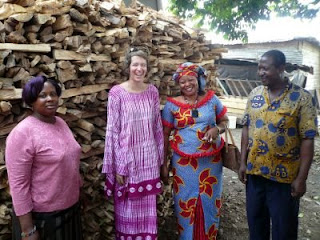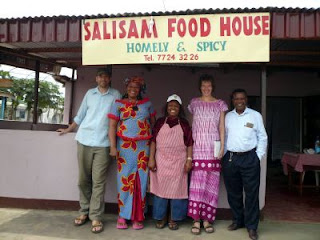Here is my final round of pictures from our trip to Buea and environs, in southwest Cameroon, a couple of weeks ago. It was a work trip, and we met several clients of the microloan program we work with at RELUFA. Ann is writing up articles about some of the people we met, for publication in the Presbyterian Church's Joining Hands newsletter. We'll share those here when they're completed. Ann is also planning to put up a blog post about the race up Mount Cameroon. We were in Buea during the race, and saw part of it.

These are some of the spices used in the food we ate. The two on the top were new to us. They are savory and delicious, and I'm not sure what to compare them to. They are key ingredients in the delicious pepper soup we tried for the first time in Beua. On the bottom is garlic and black pepper on the branch.
Meg, our Bueua contact is on the left. She is introducing us to a lady who is a client of CHAMEG, Meg's organization. She's making food from cassava, or possibly cocoyams, with a big mortar and pestle. Women prepare all the food here, traditionally, and it takes an awful lot of work.
These are cocoyams. They have no actual cocoa in them, and are not chocolatey. They are a root vegetable.
Ann, Charlie, Meg and myself. Charlie, who we met only briefly when he stopped by to see Meg, works with another NGO.
Meg in her office at CHAMEG.
Meg knows everyone in Bueua. This guy is Christopher. He's a journalist who heard we were coming and wanted to talk with Ann about why we were there and the articles she is writing.
Us, in Meg's office.
Rose and Meg. Rose works at the restaurant CHAMEG runs as part of its development work.
Ann interviews Rose.
Me and Meg in front of the CHAMEG office.
The lady on the left is also named Meg, and she is a loan client. She operates a business selling firewood. The man on the right is her husband Joseph, who runs a construction supply business. Meg buys firewood by the truckload and sells it in smaller bundles to people in the neighborhood. She sells two kinds, rubber wood (that stack in the picture) and mangrove. Mangrove is more expensive, harder, much heavier, and burns longer.
Meg also makes and sells the small breadsticks that are popular here. That's some of her stock on th eleft. The blue device is the bag sealer she uses, and the silver utensil that she's holding she uses to form the dough. She explained to us that she bought a German one awhile ago
that works well, but a Chinese one she bought recently has broken down already.
Ann interviews Meg.
Ann and Emma, another loan client. Emma operates a sewing business. She travels to other African countries and the United States occasionally to sell her stock, and also makes clothing to order, for individuals and also for weddings. People like to have special clothing made for weddings here; Emma told us about one wedding she sewed a hundred dresses for.
Emma, her assistant, and Ann. The embroidery machine the assistant is working at is what Emma bought with her loan.
Serah and Sam, loan clients who opened a restaurant.
The menu from Serah and Sam's restaurant. We ate there a couple of times. It was our first taste of Cameroonian pepper soup, one of our favorite dishes. We plan to learn how to make our own.
Ann interviews Serah and Sam inside the restaurant. They refurbished the building before they opened, knocking down the wall between the two dining rooms, painting, hanging decorations and curtains, providing furniture, building out the kitchen with a chest freezer from the US and a small gas range, and cleaning everything top to bottom. The landlord told them they had raised the value of the property considerably, since it was a nondescript dusty concrete house when they started.
Me, Meg, Serah, Ann and Sam in front of the restaurant. Homely = home-cooked, according to Sam. Spicy we can vouch for. They are working to build up their clientele; their idea for the restaurant was to provide affordable meals for students at the university in Bueua, who often live in rooms without kitchens and have trouble finding food. They said they're starting to see regular customers, not just students but government and military people too. The couple of times we were there, we always saw other customers. But they said they haven't turned a profit yet.
The beach town of Limbe. It's not too far from Bueua, so Meg brought us down here to show it to us. We sat at a cafe for a little while and looked at the Atlantic in the late afternoon. Here, Ann realizes she just got her feet all wet.
At the cafe in Limbe with Meg.
A boat in Limbe.
Meg negotiates. It was fun to watch someone do this who was obviously an expert; we always feel a little lost when we buy things.
Meg took us to the botanical garden in Limbe.
There were lots of towering trees in the garden, which covers several acres. The little pink blur at the base of the tree is Ann and Meg, to give some idea of scale. And we saw several trees that were taller than this one.
Meg and Ann in the garden.
Ann in the garden.
One of the trees in the garden.
Ann snapped this out of our bus on the way home. The toll gates on the highway have lots of vendors who sell food to passing travellers. People buy and sell through the windows, and the driver seems to keep an eye on things to avoid taking off again until people are finished. Coconuts, bananas, oranges, manioc, fresh water in plastic sachets, tissues, and all sorts of other things are available. But never anything in a bottle, for some reason, either alcoholic or otherwise.






























No comments:
Post a Comment